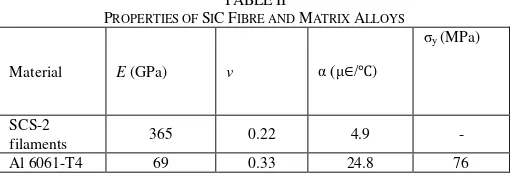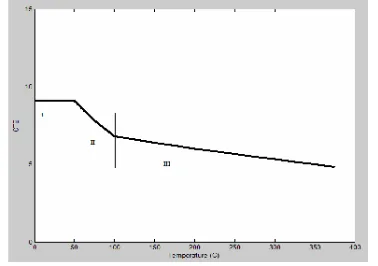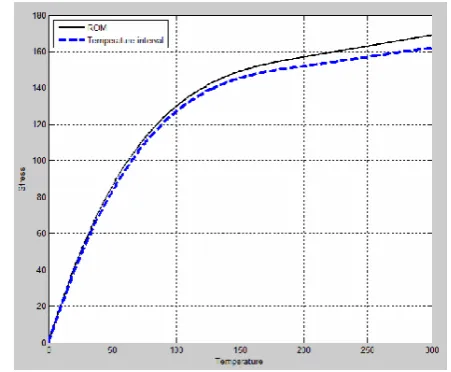Abstract—The thermal expansion behaviour of silicon carbide (SCS-2) fibre reinforced 6061 aluminium matrix composite subjected to the influenced thermal mechanical cycling (TMC) process were investigated. The thermal stress has important effect on the longitudinal thermal expansion coefficient of the composites. The present paper used experimental data of the thermal expansion behaviour of a SiC/Al composite for temperatures up to 370, in which their data was used for carrying out modelling of theoretical predictions.
Keywords—Nonlinear, thermal, fibre reinforced, metal matrix composites
I. INTRODUCTION
ETAL matrix composites (MMCs) were considered to be a strong aspirant as a structural material for high temperature applications such as engine components and gas turbines. Between the hard conditions for a high temperature material, thermal fatigue resistance was considered to be one of the most important properties. The fibre composite material has an upper strength than the platelet/particle composite; it was from a relative aspect the continuum mechanics theories of composite strengthening predicted an upper strength in the fibre composite beside that in the platelet composite [1]. Even a relatively higher work hardening rate was observed in SiC fibrous composites than in the SiC particulate ones [15].Many researches on MMCs indicate that the mismatch of coefficient of thermal expansion (CTE) between fibre and matrix was mostly answerable for the degradation of composites subjected to thermal cycling [2], and can also affect the increase of internal stresses and considerably remarkable thermal expansion behaviour of the composite [3]. It was well known that metal matrix composites were often concerned as out-of-equilibrium systems from both the mechanical and the physico-chemical aspect. Hence a study was carried out into the effect of thermal cycling under constant load on the behaviour of unidirectional long-SiC-fibres-Al-matrix
Taufik Roni Sahroni is with the Faculty of Manufacturing Engineering, Universiti Teknikal Malaysia Melaka (UTeM Hang Tuah Jaya, 76100, Durian Tunggal, Melaka, Malaysia (phone: +606-3316899; fax: +606-3316431; e-mail: [email protected])
Shamsuddin Sulaiman is with the Faculty of Engineering, Department of Mechanical and Manufacturing, Universiti Putra Malaysia (email: [email protected])
Ikhsan Romli is a master student of Manufacturing Engineering, Universiti Teknikal Malaysia Melaka
Mohd Rizal Salleh is a Dean of Manufacturing Engineering Faculty, Universiti Teknikal Malaysia Melaka (e-mail: [email protected]).
Hambali Arep @ Ariff is a Head of Manufacturing Design Department, Faculty of Manufacturing Engineering, Universiti Teknikal Malaysia Melaka (UTeM).
composites made from a semi-product manufactured by Nippon Carbon Company.The researchers have deduced that MMCs can be able to deform in a super-plastic mode when subjected to a number of thermal cycles under uni-axial tensile loading [4]-[6]. Mostly, the researchers have observed on short fibre-reinforced MMCs [4]-[8], yet for long continuous fibre MMCs also exhibited that allow to thermal ratcheting [9]-[11]. Subsequently, the effect of thermal cycling characteristics on the deformation rate has been particularly explored by Colclough et al [12]. It has shown that the hold time period at maximum temperature has little effect on the mean rate of deformation. Yet, variation of the cycling amplitude possessed a powerful effect namely; the higher the temperature amplitude, the greater was the thermal ratchetting. Moreover, the mechanism of enhanced deformation was driven by the sum of the internal stresses and the external applied stress. The previous works about modelling for the prediction of thermal expansion behaviour of composite particularly about thermal stress based on the constituent characteristics have been done by Gdoutos et al, in which proportionally analyzed using an one dimensional ROM (Rule of Mixture) model and an axis symmetric two material CCM (Composite Cylinder Model) [19]. In general the matrix CTE was much larger than that of the reinforcing fibre. Hence, internal stresses arise in the composite as the temperature changes. This causes anisotropic CTEs, particularly in unidirectionally reinforced composites. As the CTE of carbon filaments was very small compared to that of the aluminium alloy, it was obvious that large internal stresses will arise in the composite during cooling after manufacture and during thermal cycling13. The thermal stress MMCs based on SiC fibre reinforced 6061 Al have been well investigated [5], [6], [8], [12], [15], yet there still exists only limited information on the internal axial stress mode during the thermal cycling of MMCs. The amount of internal stress can be changed by thermal cycling. Changes in internal stresses cause residual dimensional changes of the composite specimens. The internal stresses of the matrix are up to 75% of the matrix yield stress [14]. The expansion of matrix alloy will be restricted by fibres while temperature one increasing and lead to longitudinal strain of composites [16]. This paper describes on strain changing against temperature and the internal axial stress mode by thermal cycling of SCS-2 fibres. The effect of interfaces type on thermal expansion behaviour was also considered.
II. MATERIALS ANDMETHOD
Unidirectional SiC, Nicalon fibres (8%, volume fraction) reinforced aluminium matrix composites were prepared by squeeze casting method. 2014 Al and 6061 Al were used as
T.R. Sahroni, S. Sulaiman, I. Romli, M.R. Salleh, H.A. Ariff
Nonlinear Thermal Expansion Model for SiC/Al
matrix alloys. Table I shows the chemical compositions of these alloys.
TABLE I
CHEMICALCOMPOSITION ANDPHYSICALCHARACTERISTIC OF2014 AND6061 AL PRE-MIXES
Chemical Composition (mass %)
Alloy Al Cu Mg Si Mn Cr
Al 6061-T4 98.05 0.25 1.0 0.6 - 0.1
Values of the elastic properties of SiC fibre and Al matrix alloys at room temperature are listed in Table II.
TABLE II
PROPERTIES OFSIC FIBRE ANDMATRIXALLOYS
Material E(GPa) v α (μ/)
σy(MPa)
SCS-2
filaments 365 0.22 4.9
-Al 6061-T4 69 0.33 24.8 76
The longitudinal thermal expansion behaviour in the temperature range at 0-370 was measured on a DIL 402C dilatometer, with heating rate of 5/min and a helium atmosphere flowing rate of 50 mL/min. The specimens with size of a 30.5 x 30.5 cm eight-layer unidirectional plate were used in this work. It was made by diffusion bonding. The average CTEs at various temperatures were obtained by the thermal expansion curves. The thermal cycling of specimens was conducted between room temperature and 177. Longitudinal strains and temperature were taken at 14
intervals and recorded by means of using a data logger. In the second type of experiment, longitudinal thermal strains were obtained at temperatures up to 370 using a dilatometer, it
due to rely on the previous experimental research [12] stated that the deformation at break after thermal ratcheting (1.71%;
Tmax = 380).
Fig. 1 Thermal strains in 6061aluminum and unidirectional longitudinal SiC/Al composite
Special cylindrical specimens, 10mm long and 3mm in diameter, were used. For this purpose three layers of the composite plate were first glued together to produce sufficient
thickness for preparation of the cylindrical specimens. The longitudinal thermal strain curves of composite and matrix alloy are shown in Fig. 1. It was observed that the longitudinal thermal strain of composite was linear with temperature up to a strain of approximately
strain of the proportional limit of 6061-T4 aluminium at ambient temperature. In the other word, thermal strain either of composite or matrix alloy increases with the elevation of temperature. This represents that thermal strain going up at a lower rate indicating a slowly declining coefficient of thermal expansion (CTE).For the micromechanical prediction of thermal deformation, the stress-strain behaviour and the thermal strain behaviour of the aluminium used to create the composite at various temperatures are necessary [17]. Throughout consolidation of the composite, the aluminium involved a heat treatment procedure which altered temperature. Aluminium of type 6061-T4 was acquired and was tested in pressure at differ temperatures. Rectangular specimens of dimensions 20.32 x 1.27 x 0.16 cm were arranged with steel tabs bonded with a high strength adhesive. The aluminium specimens were loaded in pressure in an Instron testing machine with grips competent of holding on temperatures up to 540 inner a thermal. A water cooling system was installed to cool the grips for tests at elevated temperatures. Special high temperature strain gages were used to record axial strains. Axial strains were also monitored with a special high temperature extensometer.
Fig. 2Stress-Strain curves of 6061-T4 aluminium at variant temperatures up to one percent
Stress-strain curves for aluminium at a variety of temperatures from 24-288 are depicted in Fig. 2. Only the portions of the curves up to 0.01 strains are shown. It was apparent that the proportional limit reduces with rising
the strain temperature curve becomes non-linear and the CTE increases. Values of matrix CTE at various temperatures are shown in Table III.
TABLE III
THEMAGNITUDE OF THEPROPORTIONALLIMIT, CTE OF THE6061 AL AT VARIOUSTEMPERATURES
T() my(MPa) m(μ/)
24 86.2 24.8
121 79.3 24.9
171 72.4 24.9
232 60.3 26.3
288 41.4 27.6
III. RESULT ANDDISCUSSION
A model of numbers has been evolved for the prediction of the CTE of unidirectionally fibre-reinforced composites. Corresponding to Schapery20, the CTE for a fibre-reinforced composite in longitudinal direction was presented as
(1)
where α represents the CTE, E the Young’s modulus, V the volume fraction, and the subscripts ‘||’, ‘f’, and ‘m’ represent
the composite in the longitudinal direction, the fiber and the matrix, respectively.
Rosen and Hashin [21] expanded the work of Levin to develop formulations for the CTE of unidirectional fiber-reinforced composites as:
(2)
where is the CTE of the composites calculated from the
rule of the mixture andK the bulk modulus.
Fig. 3 Coefficient of Thermal Expansion versus Temperature according to experiment
The variation of the longitudinal CTE with temperature was shown in Fig. 3. Up to 65 the measured longitudinal CTEs were small slope, i.e., α = 9.1 μ/. The longitudinal CTE of
SiC/Al fibre composites decrease along with increasing temperature toward zero when the temperature beyond to 370. The declining rate of CTE of SiC/Al changes in the range of variant temperature. After the variant declining rate of CTEs, the CTE-temperature curve was separated into three areas; slope reduction, steep reduction, slope reduction once more, i.e. I, II, III, areas in depicted Fig. 3. It has well known that the CTEs of fibre-reinforced MMCs were influenced by the thermal stresses and interfaces between matrix and fibres. The temperature would fluctuates, while the thermal stress one was allocated on the SiC fibres that manufactured by the mismatch of CTEs between the Silicon carbide fibres and aluminium alloy.
The two formulation models have been used by researcher to evaluate the thermal expansion behavior of composites. Yet, these not enable to be utilized to approach the variety of the composite CTE with temperature as shown by the poor agreement with the experimental outputs. The mechanical behaviors among other are yield strength of matrix, the interfacial debonding, and the initial stress state of component phase should be calculated for the thermal expansion behavior predicting.
According to the ROM model, the thermal stress either in the fiber or the matrix has been formulated with iso-strain hypothesis and equilibrium equation along the fiber directional longitudinally for linear elastic behavior presented as follow
(3)
(4)
where and are the volume fractions of the fiber and matrix, respectively.
Once established the stresses in the matrix and the fiber, the longitudinal strain of the composite is established by Ramberg-Osgood equation
(5)
where and are the strain and stress, the modulus
of elasticity the proportional limit of aluminum, the
coefficient of thermal expansion.
1) The composite deformation is basically one dimensional and parallel to the fibre longitudinal direction, neglecting shear stress and Poisson effect,
2) The temperature is similar in the whole composite,
3) The stresses and strains among the matrix and the fibre are uniform,
4) The metallurgy of composite was stable and the change of the structure was physically or chemically taking place while thermal cycling,
5) Interfacial sliding and fibre yielding was ignored.
For a short temperature interval , the length change
of fibers with a given length consists of thermal term
and mechanical term in the absence of
external loading [18], as follows:
(6)
where and are the CTE and Young’s Modulus of the
fibers, respectively, the stress-free length of fibers and
the internal axial stress change resulting from . Equation (6) can be rewritten as
(7)
Since , we can obtain
(8)
If no interfacial sliding, the strain of the composite is
equal to the strain of the composite is equal to the
strain of the fiber in the temperature interval of ,
i.e.
(9)
Therefore, the internal axial stress change in the
temperature interval of could be obtained by substituting (8) into (9):
(10)
If the matrix yielding or the interfacial debonding occurs, should vary greatly from (10). In this case, the
thermal expansion curves may be employed to analyze the matrix yielding or the interfacial debonding behavior of the composites.
From (10), it can be integrated along with a particularly temperature interval with initial temperature To = 30, to an certain temperature T, given by
(11)
where and are the internal axial stress of fibers
at theTandT0, respectively. It shown in Fig. 4 that the change in internal stress of fibers as function of temperature, at which was calculated from the expansion curves of Fig. 3 using (11) with taking value modulus elastic of fiber, and CTE of fiber from Table 2.
Fig. 4 Variation of the Axial Stress in the fibre, predicted by the ROM model and the CTE rate of temperature interval model
IV. CONCLUSION
The thermal expansion behaviour of the SiC/Al fibre-reinforced composite would be rely on the thermal expansion of the fibres, and influenced by the onset of interfacial strength and residual stress state, while CTE measurement one do not take place interfacial sliding. The effect of mismatch of CTEs between the matrix and fibres is that strengthening residual compressive stress in the fibres, as the SiC/Al fibre-reinforced composite is refrigerating from the upper temperature of the last cycle. The early compressive stress gradually decline toward zero, and then a tensile stress of fibre progressively raises, these are resulted of the positive value of initial stress.It can be apparent that the change in internal stress of fibres in composite was non-negative and going up with temperature. The variant CTE along in the temperature lead to be three regions with fluctuate slopes in Fig. 3. The slope of range I in toward zero. In order to the SiC/Al fibre-reinforced composite treated to TMC, the internal stress change of fibres by using the temperature interval from 0-65 is less than that of range III from 100-370. In the range II from 65-100, the slope
is the CTE rate of temperature interval model is almost near to the ROM model.
REFERENCES
[1] R. J. Arsenault. The Strengthening of Aluminium Alloy 6061 by Fibre and Platelet Silicon Carbide. Materials Science and Engineering, 64 (1984) 171-181.
[3] Nan-Ming Yeh and Erhard Krempl. A Numerical Simulation of the Effects of Volume fraction, Creep and Thermal Cycling on the Behaviour of Fibrous Metal Matrix Composites. Journal of Composite Materials. 26 no 6 (1992).
[4] B. Derby, Internal Stress Super-plasticity in metal matrix composites, Scr. Metall., 19 (1985) 703-707.
[5] S. M. Hong. Internal Stress Super-plasticity in 2024 Al-SiC whiskers reinforced composites, J. Compos. Mater., 22 (1985) 102.
[6] K. Wakashima, B. H. Choi and S.H. Lee, Metal Matrix Composites,
Proc. 3rd Jpn.-U.S. Conf. On Compoosite Materials, Tokyo, 1986, 1986, pp. 579-587.
[7] J.C. Leflour and R. Locicero, Influence of internal stresses induced by thermal cycling on the plastic deformation resistance of Al/SiC composite material, Scr. Metall.,21 (1987) 1971 -1976.
[8] G. S. Daehn, Plastic deformation of continuous fiber reinforced composites subjected to changing temperature, Scr. Metall., 21 (1989) 247-252.
[9] S. Yoda, N. Kurihara, K. Wakashima and S. Umekawa, Thermal cycling induced deformation of fibrous composites with particular reference to the tungsten copper system. Metall. Trans. A 9 (1978) 1229-1236.
[10] B.K. Min and F.W. Crossman, History dependent thermo-mechanical properties of graphite aluminium unidirectional composites. Proc. 6th ASTM Conf. On Composite Materials. Testing and Design in ASTM Spec. Tech. Publ.787, 1982, pp. 371-392.
[11] E.G. Wolff, B.K. Min and M.M. Kural, Thermal cycling of a unidirectional graphite-magnesium composite. J. Mater. Sci., 20 (1985) 1141-1149.
[12] Colclough, B. Dempster, Y. Favry and D. Valentin, Thermo-mechanical behaviour of SiC-Al Composites, A 135 (1991) 203-207.
[13] H. Mykura, N. Mykura. Thermal Expansion and Stress Relaxation of Metal Matrix Composites. Composites Science and Technology, 45(1992) 307-312.
[14] G. Neite, S. Mielke. Thermal expansion and dimensional stability of alumina fibre reinforced aluminium alloys. Materials Science and Engineering. A148 (1991) 85-92.
[15] C.S. Rao and G.S. Upadhyaya, 2014 and 6061 aluminium alloy based powder metallurgy composites containing silicon carbide particle or fibre. Mater. Design, 16 no. 6 (1995), pp. 359-366.
[16] Song Mei-hui, Xiu Zi Yang, Wu Gao Hui, Chen Guo Qin. Nonlinear temperature characteristic of thermal expansion of Grf/Mg Composites. Transaction Nonferrous Metals Society of China. 19(2009), pp. S382-S386.
[17] D. Karalekas, E.E. Gdoutus, I.M. Daniel. Micromechanical Analysis of Nonlinear Thermal Deformation of Filamentary metal matrix composites. Computational Mechanics (1991) 9, pp. 17-26.
[18] D. Masutti, J.P. Lentz, F. Delannay. Measurement of internal stresses and of the temperature dependence of the matrix yield stress in metal matrix composites from thermal expansion curve. Journal of Material Science Letters, 9(1990), pp. 340-342.
[19] E.E. Gdoutos, D. Karalekas, and I.M Daniel. Thermal Stress Analysis of a Silicon Carbide/Aluminium Composite. Experimental Mechanics. Vol 31 (1991) no3, pp. 202-208.
[20] R.A Schapery. Thermal expansion coefficients of composite materials based on energy principles. Journal of Composite Materials, 1968. Vol. 2 no 3, 380-404.


